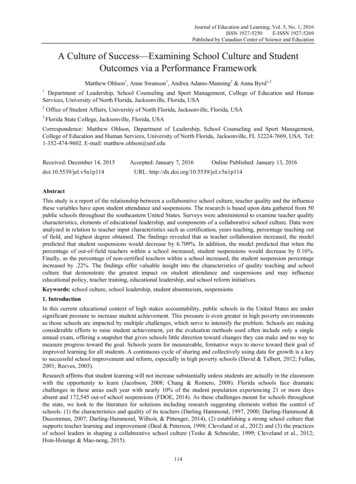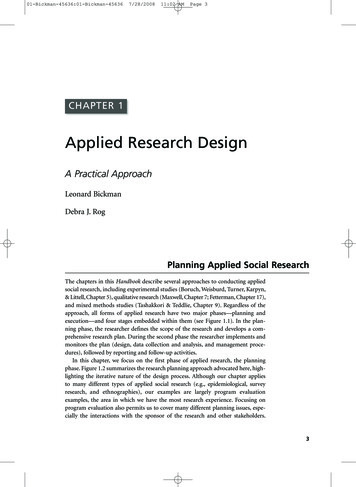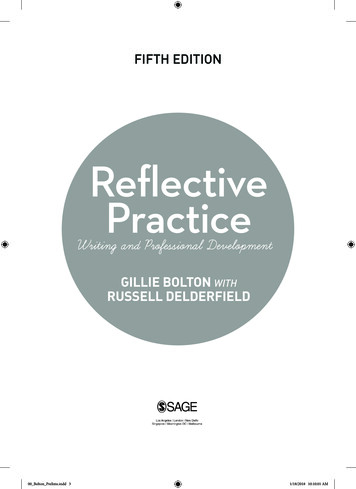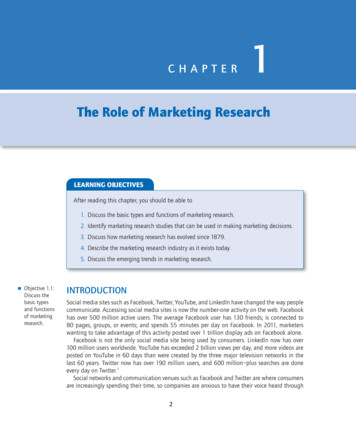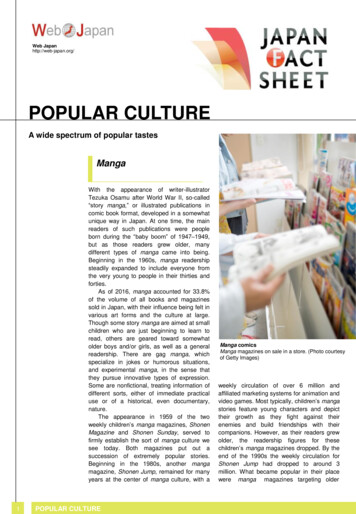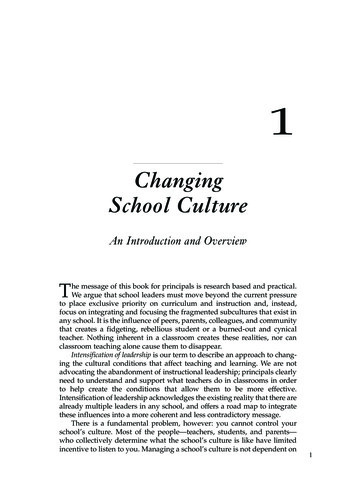
Transcription
1ChangingSchool CultureAn Introduction and OverviewThe message of this book for principals is research based and practical.We argue that school leaders must move beyond the current pressureto place exclusive priority on curriculum and instruction and, instead,focus on integrating and focusing the fragmented subcultures that exist inany school. It is the influence of peers, parents, colleagues, and communitythat creates a fidgeting, rebellious student or a burned-out and cynicalteacher. Nothing inherent in a classroom creates these realities, nor canclassroom teaching alone cause them to disappear.Intensification of leadership is our term to describe an approach to changing the cultural conditions that affect teaching and learning. We are notadvocating the abandonment of instructional leadership; principals clearlyneed to understand and support what teachers do in classrooms in orderto help create the conditions that allow them to be more effective.Intensification of leadership acknowledges the existing reality that there arealready multiple leaders in any school, and offers a road map to integratethese influences into a more coherent and less contradictory message.There is a fundamental problem, however: you cannot control yourschool’s culture. Most of the people—teachers, students, and parents—who collectively determine what the school’s culture is like have limitedincentive to listen to you. Managing a school’s culture is not dependent on1
2Building Strong School Culturesthe authority that you have based on your position, but can only be affectedby increasing your influence over behaviors, beliefs, relationships, andother complex dynamics present in the school that are often unpredictable.Before we begin to examine schools that have made lasting culturalchange, we offer a caveat. It is beyond the scope of this effort to assess theissues of changes in educational policy or public attitudes that provide thebackdrop for principal’s work but over which they have little influence.Nor do we deal with schools in crisis; those in which academic performance and teacher morale suggest a need for a dramatic “fresh start.” Theissues we address will be those facing the vast majority of “typicalschools” and “typical school administrators.”There is a tradition in the school reform literature that treats elementaryschools, middle schools, and high schools as if they are vastly differentplaces. While this is true when the discussion focuses on specific curricularor instructional strategies, such as the efficacy of early reading programs orAP coursework, our research (and that of others) suggests that schools havemuch in common. Every principal faces similar challenges when faced withchanging the “way we have always done things here.” It doesn’t matter ifan elementary school adopts 4-block reading or a high school implementsblock scheduling, school leaders will face similar forms of resistance, skepticism, and challenge. The old adage that high schools teach subjects andelementary schools teach children is countered by the finding that grade andother teams exert influences in elementary schools that can be every bit aspowerful as those of departments at the secondary level.To illustrate our approach, throughout the book we will consider casesdrawn from real schools and principals who have done things right—or wereblindsided by unanticipated events and consequences of their own actions.The authors of this book are researchers who have collectively spent morethan fifty years trying to understand the world of teachers, administrators,and students. To understand these worlds, and to seek solutions to problemsof practice, we have grounded our approach in organizational and management theories that were not specifically written for education. We have alsobeen in the classroom and have worked directly with many schools and educational professionals, so we have the capacity to pull what is relevant fromthis broader and more abstract base. We hope that a novice school leader willfind our analysis and recommendations useful to guide beginning efforts totake a more active role in shaping school cultures. We also expect that expert,experienced school leaders will read this book and find it affirming as theysee themselves in our vignettes and recommendations.This chapter will introduce the key assumptions, concepts, and topicsthat serve as the basis for the remainder of the book. How we perceivethe nature of school culture is central to developing an intensification ofleadership to change that culture. Just as physicists sometimes conceptualize light as a wave and sometimes as a particle, we will describe schoolcultures as both stable and fluid. We will introduce the acronym PCOLT todescribe three key conditions for creating constructive school cultures:professional community, organizational learning, and trust. At the end of
Changing School Culturethe chapter, we will discuss the allure of the “quick fix” and explain whyculture change requires moving beyond a fixation with short-termimprovement, whether in achievement scores or in attendance at back-toschool night for parents.SCHOOL CULTURES: STABLE ANDFLUID OR STABLE AND FRAGILEDuring the twentieth century, principals were held responsible for organizing schools to ensure that curriculum and instruction were effectivelysupervised and that the “core business” of school organization was protected from disruption. A primary role of principals was to keep teachersbuffered from the distractions of the external community. By focusingattention on what occurred inside the school, it was reasoned that schoolprincipals could manage the day-to-day events of the school in a mannerthat optimized student learning.However, recent research has begun to shift attention away from themaintenance tasks of school management to focus on school leaders’responsibility for creating cultures that are innovative and adaptable. Ourown work on professional community, which was initially developed in theearly to mid-1990s, exemplifies both the increasing emphasis on continuousimprovement as well as the need for principals to build and solidify moredynamic relationships among educational professionals. In other words, weaffirmed the primacy of leadership in shaping the culture within the school.By looking at culture through the lens of Edgar Schein, in whichculture has three layers—artifacts, espoused values, and fundamentalassumptions—we propose a framework of leadership and managementthat is particularly conducive to effecting change (Schein, 2004).A school’s culture is characterized by deeply rooted traditions, values,and beliefs, some of which are common across schools and some of whichare unique and embedded in a particular school’s history and location.Culture informs the ways in which “things get done around here” and, justas important, frames how change efforts are perceived. Based in accumulated experiences, a school’s rules and regulations, polices and procedures,whether written or informal, are the lasting artifacts of old organizationallessons. Here’s an example:ISOLATION AT CORSON MIDDLE SCHOOLSeveral years ago, as part of a shift to a middle-school structure, Shirley Preston, the principal of Corson Junior High School, was asked by the district curriculum director to createinterdisciplinary teaching teams for all fifth- through eighth-grade students. Prior to the(Continued)3
4Building Strong School Cultures(Continued)new district policy, departments had significant influence over teaching and, by all measures, they functioned well. Department members met regularly to discuss curriculumand instruction as well as to troubleshoot observed difficulties in learning. Trust was highboth within and among departments, and members enjoyed strong professional and personal relationships. The district predicted that the shift to interdisciplinary teams wouldgo smoothly since so many foundational teaming behaviors were in place. From thestart, however, the shift to interdisciplinary teams went poorly. Teachers resented theirlack of involvement in the original middle-school decision as well as the changesrequired of them. Old relationships suffered and new ones were slow to form. Ratherthan the communal focused meetings that were the norm under the old departmentstructure, interdisciplinary team planning time quickly evolved from conflictriddled gatherings into brief perfunctory conferences. Teachers began to close their doorsto each other and individualism became normative as trust eroded. Years later, the culture at Corson Middle School still suffers from this transition. Innovation is isolated andrare, and the middle-school ideal of teaming is virtually nonexistent.Conversely, we have been in many schools where trust is high, communication effective, openness is encouraged, and dissent and conflict areviewed as opportunities for creative problem solving. The culture is a positive force for reform. In these schools, students and teachers can be seenengaging in practices that encourage learning. These kinds of practices areexamples of Schein’s “artifacts” of culture and exemplify the ways inwhich culture can be stable and positive. These artifacts are covered inmore detail in Chapter 3, where we present a framework of leadership andmanagement behaviors that are particularly conducive to effecting change.Yet stability, even in a positive culture, is not enough to foster lastingimprovement in school organizations. Consider the case of Corson JuniorHigh, where the decision to move to a middle-school model was based ona thoughtful consideration of the research on early adolescent development and learning. The principal might have expected some reluctance tochange, but she also expected the positive artifacts of the old stable structure to emerge intact in a radically new educational structure. The greaterthe structural change, the more likely tacit assumptions will surface inunanticipated ways. It is when change occurs in an organization that thechange agent finds out if the culture was stable and fluid—or stable andfragile. As schools seek to develop cultures that are both stable and fluid,they must search for ways to both surface that which they believe is important and allow for new futures to be imagined.Corson’s principal was surprised that the positive, stable culture at herjunior high school became fragile when confronted with fundamentalchange. If she had worked with the staff to give them opportunities to
Changing School Culturemake the new structure their own (and perhaps integrate some of theexpertise that existed in the departments), could the interdisciplinaryteams have struggled to find a new way of working? If the district curriculum coordinator had encouraged teachers to take responsibility fordesigning a school program that provided students with an interdisciplinary and personalized experience, but allowed time for within-subject curriculum development, could the transition have been managed by the staffthemselves? Would providing opportunities in which tacit assumptionsand values were surfaced and explored have helped to provide a bridgebetween what was culturally valued in the old structure and a dream forthe new one? Culture is too complex to follow a static blueprint for change.What seems stable may shift as the social equations the actors have takenfor granted are altered. Culture always will be the creation of its participants in response to each other and outside stimuli. For a culture to remainadaptive and fluid, the participants must have a hand in creating the newstructures that grow out of the old. We hope that our book will provideyou with the understanding and tools needed to develop strategies foraddressing similar issues in your school.One function of culture is to provide meaning and self-esteem, but apositive school culture does this as it improves organizational performance. This requires the principal to balance several foci. If the stakeholders in a school cannot take ownership of a change process, then self-esteemwill be preserved by some form of blame on “the idiots that did this tous”—thereby absolving themselves of responsibility.Figure 1.1 suggests that leadership in schools must balance an emphasis on creating stability and change, and between tending to the internalfunctioning of the school and paying attention to relationships with stakeholders outside.We know that the typical principal will look at this figure and groanthat it’s just too much. Research suggests that this sense of overload isbased on the real explosion of expectations and tasks for school administrators (Cooley & Shen, 2003; DiPaola & Tschannen-Moran, 2003). Weagree with the typical principal: the leadership job that we have observedin today’s schools is ever larger and ever more complicated, and no oneperson or administrative team can do it all. But rather than dividing up theexisting leadership pie among more people, we suggest that the size of thepie also needs to be increased to include new tasks that are just beginningto emerge.An up-to-date principal will have been inundated with popular andprofessional literature that emphasizes the need to set priorities and focuson instructional leadership. This usually means challenging teachers toimprove curriculum and instruction, spending more time in classrooms,and mining data to provide evidence of how well the school is achievingits student-learning goals. Also, they also have to spend their time working on goals that are more clearly connected with more general school5
Building Strong School CulturesFigure 1.1 Organizational Culture and LeadershipEmphasis on Cohesiveness and StabilityIntensifiedLeadershipExternal FocusInternal Focus6Emphasis on Adaptation and Flexibilityclimate, meeting state requirements, discipline, and organization (Whitaker& Turner, 2000). Studies of how effective principals operate when there isa high demand for change suggest that effective leaders enact six functions(Heller & Firestone, 1995):1. Providing and selling a vision2. Providing encouragement and recognition3. Obtaining resources4. Adapting standard operating procedures5. Monitoring the improvement effort6. Handling disturbancesA quick perusal of these functions suggest that some involve maintenance(for example, providing encouragement or handling disturbances), whileothers emphasize change (selling a vision and adapting school procedures).Changing a school’s culture to balance stability and change is not aneasy task. A principal’s ability to shift from the traditional internal priorities of curriculum, instruction, and maintaining a smooth and orderlyenvironment is limited both by time constraints and the expectations ofteachers. Current leadership literature suggests that there are solutions, such
Changing School Cultureas establishing teacher professional learning communities and encouragingpeer consultation and coaching, that can augment the principal’s instructional role, but, without a great deal of attention to roadblocks and details,can easily be perceived as another temporary innovation that will pass (Hord& Sommers, 2008) or even what Andy Hargreaves calls “contrived collegiality”that is manipulated by administrators for their own purposes (Hargreaves &Dawe, 1990). Changing a school’s internal culture demands that designatedschool leaders have real partners within the professional staff and thatteachers want and exercise influence in areas outside the classroom.In addition, resilient school improvement is more likely to occur if theprincipal focuses not just inside the school but also on redefining the relationship between school professionals and their communities. Evidence isincreasing that effective school leaders are engaged with their local contextand make student learning a task that can be supported by many. Principalsoccupy a singular position that permits them to act as boundary-spanners,creating solid links between the school (the primary site of formal studentlearning) and the community (the primary site of informal student learning). Creating bonds with other educators outside the school, through principal networks and more collaborative relationships with district officestaff, can serve as a significant source of stimulation and reflective administrative practice. (We address these issues in Chapters 5, 6, and 7.)Our perspective is broader than just increasing parental involvement orcreating linkages with community service agencies, and we reject the dominant belief that interactions with the community should be driven by apublic-relations focus that emphasizes successes, downplays failures, andlimits transparency. Based on research, which we review in Chapter 7, weargue that the school’s interpretive frame should shift away from lookingat the community as a resource to support teachers and classrooms towardseeing it as a locus for student learning and development. In fact, we arguethat deep-seated changes in the culture of schools are unlikely to occurwithout action to create more fundamental bonds with the community.Creating community bonds and building trust with immediate stakeholders is no longer enough to ensure sustained support for a particularschool and public education in general. Principals are increasingly expectedto be entrepreneurial and to develop new alliances that can help schoolsmeet their goals for student learning and development. Images of schoolsas full-service providers of health and social service care are plentiful in theschool reform literature, and principals are looking for partners in businesscommunities and other agencies to develop new programs ranging fromon-site preschools to networks of service learning and internship opportunities. Never before have schools felt such pressure to support healthyyouth development—at the same time that they are mandated to raise testscores. Most surveys do not measure the attention that principals give tothis part of the job, and those that have indicate that principals still give thispart of the job limited priority (Goldring & Hausman, 2001), but our informal observations suggest that this demand is increasing. This represents a7
8Building Strong School Culturesdramatic shift in school culture because it changes the dynamic from onethat is focused on students in classrooms to one that emphasizes the connections of the school with the wider world of foundations, businessgroups, social service providers, and government agencies.INTRODUCING PCOLT—PROFESSIONALCOMMUNITY, ORGANIZATIONALLEARNING, AND TRUSTSchool administrators are not anthropologists; they are concerned withschool cultures as a means to positive outcomes. This book focuses on thecultural attributes of schools that create better opportunities for thestudents who attend. Thus, improving culture is not an end in itself, butthe means by which school leaders can address the goals of studentprogress and achievement. Three features of school cultures that have beentied to student learning in multiple studies are:1. Professional community. Professional community (PC) directs aspotlight on the relationships among adults within the school. By focusingon the structural and human resource conditions necessary for schools tobecome strongly connected around the goal of student learning, the framework suggests that strong school cultures are based on shared norms andvalues, reflective dialogue, public practice, and collaboration (Louis &Kruse, 1995). The essence of professional community is that all adults in aschool are presented with the opportunity to work with others to grow andchange—and that meaningful and sustained connections are necessary forthat to occur. This occurs when teachers take collective responsibility forimproving student learning. Collective responsibility, in which all membersfeel accountable for all students, is at the core of intensified leadership.2. Organizational learning. The concept of organizational learning(OL) suggests that continuous improvement through collective engagement with new ideas will generate enhanced classroom practices anddeeper understanding of how organizational improvement occurs. Theidea is frequently coupled with that of professional community in programs that are designed to create more visible “professional learning communities” (Hord & Sommers, 2008; Stoll & Louis, 2007). However, not allgroup learning occurs in organized meetings, and we wish to emphasizethe uncertainty of predicting which structures and experiences will produce the “aha moment” that helps to shift the culture from old to newvalues, beliefs, and practices. Seemingly random contacts with novel ideas,as well as structured efforts to examine data and plan new programs, mayproduce forward momentum. OL focuses on the ways in which new ideasare brought into the school organization, how they are considered and evaluated, and the ways in which school organizations retain and use the
Changing School Cultureknowledge generated from them. Organizational learning generally occurswhen groups acknowledge small failures and consider alternatives, andthis occurs more often when more people take responsibility for problemfinding and problem solving (Levitt & March, 1988).3. Trust. Trust is the glue that holds social networks and relationshipstogether. In schools, trust is considered to be the result of several dispositions working in concert. Among these are integrity (or honesty and openness), concern (also called benevolence or personal regard for others),competence, and reliability (or consistency). Trust is also low in schools thatfeel beleaguered by public pronouncements that they are failing—not a message that is designed to create positive collaboration. Trust has been linkedwith organizational effectiveness in business settings; in schools, trustamong teachers and between teachers and other groups is linked to higherstudent achievement (Tschannen-Moran, 2004). While principals cannotbear full responsibility for creating trusting cultures in their schools, theirbehavior sets a tone and a foundation for creating trusting relationships andprofessional community in other groups (Bryk & Schneider, 2002).These ideas are increasingly familiar to school leaders and teachers,and many programs and staff development opportunities are designed toincrease principal’s ability to work with them. However the assumptionsunderlying PCOLT stand in stark contrast to the deeply embedded understanding of many school professionals about how schools should operate.Dan Lortie observed that teachers generally assume that they will workalone rather than with other adults, that the difference between their workand administrator’s work constitutes a bright line that is seldom crossed(Lortie, 2002). Thus, there is a chasm between professional aspirations fordynamic and caring cultures and the reality encountered by many principals when they arrive at the schoolhouse door each morning.Our research suggests that while many schools are working hard todevelop school cultures characterized by professional community, organizational learning, and trust (which we refer to as PCOLT), there is a greatdeal of variation in the degree to which they have shifted their values awayfrom older mental models. Cultivating these values can be a juggling act,and, as shown in the Corson example, a solid, positive culture can quicklyerode when confronted with change. Our argument is that principals andother school leaders can guide their schools toward this goal and, once theschool is moving in the right direction, help to sustain the momentum.PCOLT is most powerful when the ideas that underscore each of thethemes are viewed as strategic actions to build strong adaptive schoolcultures. Furthermore, our thinking positions PCOLT as an enduringapproach to leadership behavior and temperament. Building a strongschool culture is not something you do once, nor is PCOLT something youcan claim to become—it is an orientation toward school leadership thatsets the stage for achieving your goals for student success.9
10Building Strong School CulturesINTENSIFIED LEADERSHIP: AN INTRODUCTIONEmploying PCOLT strategies requires a different kind of school leadership. We choose to call this form of leadership intensified because itincreases the number of people engaged in leadership roles and the scopeof the school’s work as it relates to student outcomes. Other words beenused to capture the changing nature of leadership in contemporary settings, ranging from shared leadership and site-based management, toservant and distributed leadership. Intensified leadership builds on theinsights of these models.Shared leadership and site-based management in most forms are limited to involving a variety of stakeholders in making decisions (Bauch &Goldring, 1998; Leithwood & Duke, 1998). Servant leadership, as a criticalconcept, emphasizes the role that formal leaders play in supporting thegoals and work of others (Block, 1993). Mayrowetz and his colleagues distinguish between two ways of thinking about the distribution of leadership in a school. One describes how influence operates in schools—who hasit and under what circumstances (Gronn, 2000; Spillane, Halverson, &Diamond, 2001), while the other prescribes sharing leadership as a meansof reallocating the work of school improvement (Mayrowetz, Murphy,Louis, & Smylie, 2007).In our view, the term intensified leadership combines both the descriptive and prescriptive perspective, and it unavoidably includes elements ofshared and servant leadership. It assumes that there is deliberately broadenedmeaningful involvement—through job redesign and through the permanentredistribution of the work. It goes beyond saying that people will see theirwork as encompassing more tasks. By deepening their collective responsibility for finding and solving problems, selecting tasks and foci, peoplebecome more accountable for meshing the larger goals and vision of theschool with the smaller tasks of daily leadership and management. Thus,it goes beyond simply giving the school’s work to more people, anddemands that all members of the school community become active decision makers. The implication is that there is no longer a single leader, oreven a small leadership team. Intensified leadership suggests that leadership roles must meaningfully and purposefully be inhabited by the many.What this means in practice will become apparent as we present cases ofleadership intensification through the remainder of the book.Our notion of intensified leadership challenges the seductive image ofthe heroic leader. Traditionally, a hero or heroine “leads” by making critical decisions concerning organizational vision and goals, and sets a clearpath for their attainment. Heroic leaders are portrayed as knowing theright thing to do and exactly when to do it. By making decisive choices andproviding directions for others to accomplish these goals, heroic leadersmotivate others to achieve success. This traditional representation of leadership positions the heroic leader as more intelligent, charismatic, and
Changing School Cultureinsightful than other members of the organization and holds the leaderultimately responsible for the success or failure of the organization. Whilethe scholarly literature has trumpeted the demise of heroic leadership forseveral decades, the popular press continues to demand it and replacement terms such as “transformational leadership” (Bass, 1998) and “superleadership” (Manz & Sims, 2001) do little to dispel the largely patriarchalimage.The problem with viewing leadership in this way is simple—it can’twork in today’s schools. The issues schools face are too complex, the pressures of day-to-day operations too complicated, and the stakes too high tosuggest that an all-knowing leader—or even an all-knowing superleadership team—can succeed. Furthermore, this conception belies the truth ofhow school organizations work. From the office assistant who chooses tospend time with a parent new to the district, to the classroom teacher whochooses homework assignments, important decisions are made at all levelsof the organization on a daily, even hourly, basis. In reality, leaders whoattempt to lead heroically reduce the effectiveness of their followers, overburden themselves, and impair the organization’s ability to respond adaptively to issues that may arise.In contrast, intensifying leadership suggests that rather than focusingenergy in one location or person, leadership is enhanced by the interactionand networking of many organizational members. By expanding the conception of who leads to include teachers, parents, and the wider community, schools have the potential to better meet the challenges they face.Intensifying leadership highlights the notion that leadership can beviewed as the intellectual and social outcomes of a group of interactingindividuals. One prominent researcher likens this kind of leadership to anetwork of influence in which formal positions are less important than thebelief by others that each person makes a difference (Spillane, Halverson,& Diamond, 2001). Another proponent of this perspective argues that theneed for intensification demands a different “architecture” for school organizations that abandons the image of vertical authority (Gronn, 2000).Rooted in communal action, intensified leadership suggests that whenorganizational members work in concert with each other they can pooltheir individual knowledge and expertise, resulting in better outcomes.Furthermore, intensified leadership is more than empowerment of individuals to complete specific tasks. The empowerment literature emphasizes the transfer of existing decision-making functions from schoolleaders to teachers through new special roles or structures in whichteachers can exercise influence (Marks & Louis, 1997). While it is arguedthat sharing decision-making responsibil
1 Changing School Culture An Introduction and Overview Themess


